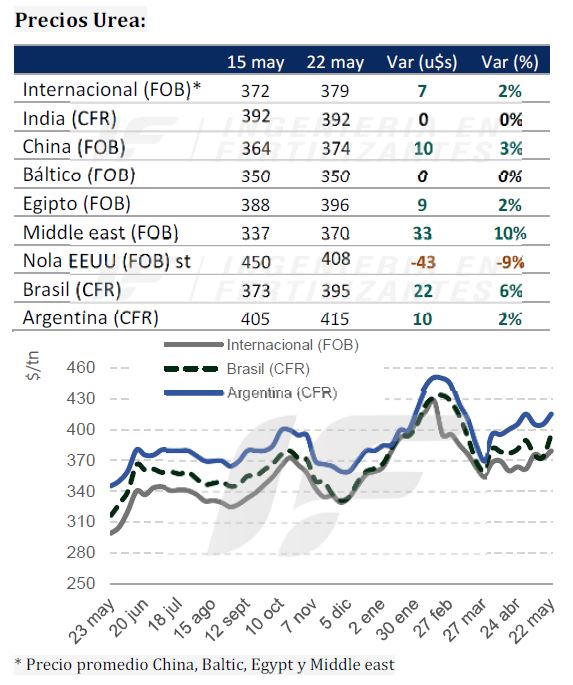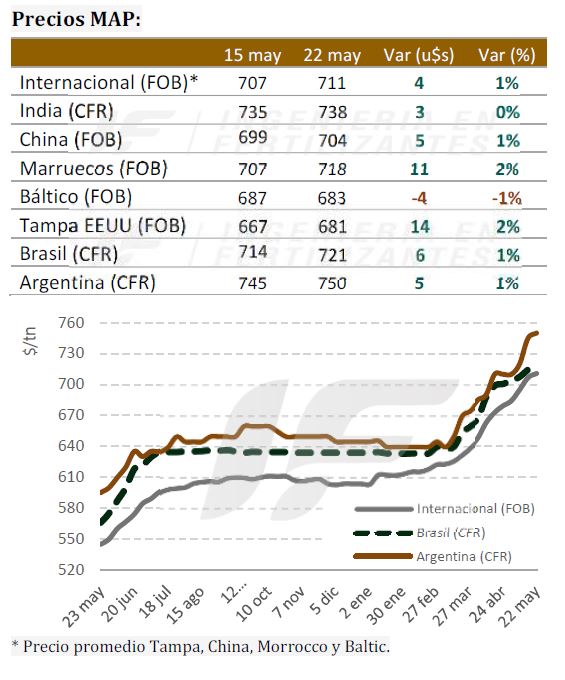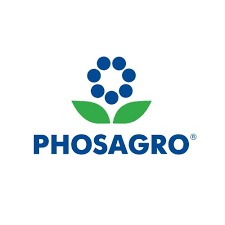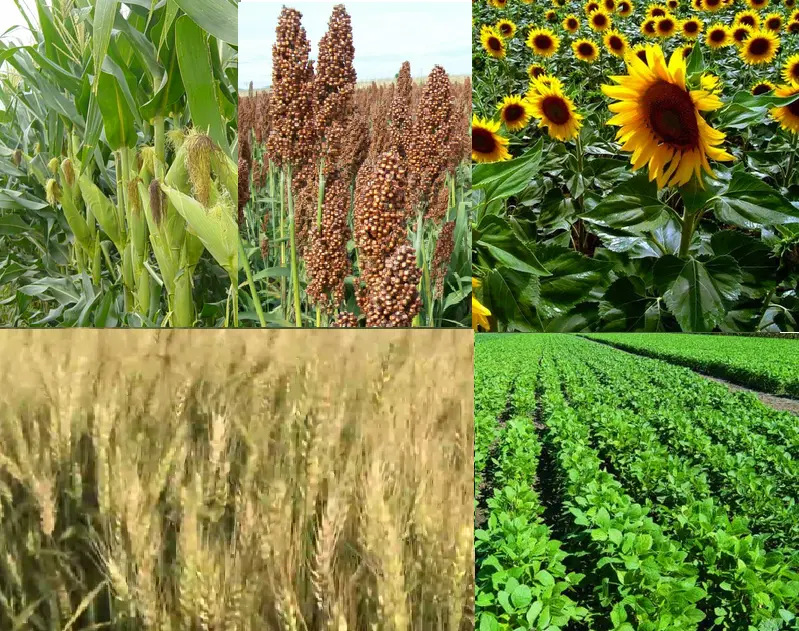
In the midst of the Argentine fine grain sowing season, phosphate fertiliser prices continue to rise, while granulated urea prices are showing signs of a probable recovery.
The latest trade report from the consulting firm IF Ingeniería en Fertilizantes indicates that there has been a reduction in the supply of urea in Egypt because several factories in that country have suspended operations due to gas cuts, while there are expectations for a new tender in India that could be for 1.0 to 1.5 million tonnes.
‘Although China’s process of opening up urea exports will begin at the end of May, the first shipments are not expected until mid-June,’ the report notes.
In Brazil, activity increased and sales of up to 20,000 tonnes were reported at prices of 380-385 USD/tonne CFR, but by midweek some buyers agreed to pay 410 USD/tonne with immediate availability.
‘The Argentine market was more dynamic than the Brazilian market. Buyers are showing greater urgency to secure cargo for June, due to better weather conditions and tighter logistics,’ the consultancy notes.

‘In the short term and within the next 30 days, we are likely to face a period of firm urea prices,’ the report anticipates.
As for the phosphate market, prices continue to rise due to active purchases by India, which continues to anticipate the monsoon season, and South America.
‘In China, exports are picking up under a quota system, with the first shipments expected by the end of June. Restrictions on exports to India will limit the volume available for export,’ explains the consulting firm.
In Brazil, although the market remains active, some destruction of demand is beginning to be seen, as producers consider reducing phosphorus doses or replacing MAP with cheaper TSP/SSP.
‘In Argentina, some purchases were recorded at values around 745-755 USD/tonne CFR, which generates wholesale costs of approximately 850 USD/tonne for the local market,’
Source: ValorSoja

Phosagro may begin water-soluble fertilizer exports to Azerbaijan by the end of 2025
Russian producer of phosphorus-based fertilizers PhosAgro plans to begin exports of water-soluble monoammonium phosphate to Azerbaijan by the end of 2025. The announcement was made by PhosAgro-Region CEO Andrey Vovk during the 18th Azerbaijan International Agricultural Exhibition Caspian Agro.
The fertilizer, marketed under the APALIQUA NP 12:61 brand, is a fully water-soluble nitrogen-phosphorus product designed for fertigation and foliar feeding across various crops. It is expected to complement APALIQUA NP 11:37, a liquid complex fertilizer that PhosAgro began supplying to Azerbaijan in May 2023.
“Interest in liquid forms of mineral nutrition in Azerbaijan is definitely growing,” Vovk said at the exhibition. “Today we are taking another step and introducing water-soluble ammophos, which has proven effective both in difficult Russian conditions and in regions with a hot climate.”

The new product is manufactured at the Volkhov branch of JSC Apatit, part of the PhosAgro Group, which launched production of water-soluble monoammonium phosphate in January 2023. Sales and agronomic support in Azerbaijan will be handled by PhosAgro-Region.
According to the company, registration of the fertilizer in Azerbaijan is nearing completion. Testing and demonstration trials are scheduled for summer 2025 in collaboration with local partners and producers.
Dmitry Sushkov, Director of Sales to CIS countries at PhosAgro-Region, noted that the company goes beyond supply, offering agronomic services tailored to individual farms. “We carry out assessments of soil fertility and moisture availability and develop fertilizer recommendations, including full-scale nutrition systems,” he said.
The fertilizer is targeted at farms in regions with hot climates and limited water availability, where conventional granular fertilizers may be less effective. According to the company, use of water-soluble ammophos as part of an integrated nutrition system can enhance both yield and quality of horticultural and vegetable crops.
PhosAgro has been active in Azerbaijan since 2014. Its product portfolio for the local market includes around 20 fertilizer brands. In 2025.
Source: FertilizersDaily

ARGENTINA’S MAIN CROPS OVERVIEW
WHEAT
As of this report, we mark the beginning of the 2025/26 wheat season with 3.4% of the projected 6.7 million hectares already planted, reflecting a 6.3% year-on-year expansion. The most significant progress has been made in the northwest of the agricultural area, although some sectors are showing limited moisture availability, so any additional
rainfall during the planting window could positively influence sowing intentions. However, delays in the harvest of summer crops are now compounded by rainfall recorded over the past week in the center-east and south of the agricultural area, which interrupted early planting progress in the core zones and Buenos Aires. This scenario results in a year-on-year delay of 10 percentage points and 4 percentage points behind the average of the last five seasons. Additionally, excess moisture may hinder field access and, if these events persist, could lead to a shift from long-cycle to intermediate or short-cycle varieties, depending on availability and local conditions.
SOYBEAN
Following a weekly progress of 9.4 percentage points, the national soybean harvest has reached 74.3% of the suitable area, with an average yield of 3,1 tons per hectare. So far, 81% of first-crop soybeans have been harvested, and in Córdoba, the campaign is nearing completion with good yields averaging 3,4 tons per hectare. At the same time, 56%
of the suitable area for second-crop soybeans has been harvested, with yields exceeding expectations in Córdoba, Entre Ríos, northern La Pampa–western Buenos Aires, and the Southern Core region. Recent rainfall, with significant accumulations centered in northeastern Buenos Aires, has slowed harvest operations in that area, where 21% of the
remaining harvestable area is located. In this region, harvest interannual delays reach 9 percentage points in the Southern Core (mostly second-crop fields) and 20 percentage points in northern La Pampa–western Buenos Aires, affecting both first- and second-crop fields. It remains to be seen whether the current yield trend will hold following the
recent rains. Under this scenario, we maintain our production forecast at 50 million tons.
CORN
The corn harvest for grain continues to advance slowly across late-planted fields, constrained by the previously mentioned rainfall. In addition, in regions not affected by the rains, many fields have yet to reach optimal harvest moisture. To date, 38.8% of the national area has been harvested, with an average yield of 8 tons per hectare. In
Córdoba province, expected yields for late-planted corn are estimated at 8.3 tons per hectare in the Center-North and 7.8 tons per hectare in the South. In the former, these yields—despite a significant drop in planted area—would allow for an 11.8% year-on-year increase in production, highlighting that this zone was among the hardest hit by “Corn
leafhopper” (Dalbulus maidis) last season. In contrast, in the southern part of the province—where the pest had less impact in the previous campaign—production is expected to fall by 23% year-on-year, mainly due to reduced planting area. Within this context, the national production forecast is maintained at 49 million tons.
SORGHUM
To conclude, the grain sorghum harvests advanced 5.2 percentage points compared to the last crop report, reaching 40.5% of the national planted area. Producers have prioritized harvesting soybean fields, so it is expected that the pace of sorghum harvest will pick up in the coming weeks. Both in the NEA (Northeast Argentina) and the Center-North
of Santa Fe, the main sorghum-growing regions, yields are expected to be below initial expectations, averaging around 2.6 tons per hectare due to the stress experienced during the summer. On the other hand, with 45% of the crop already harvested and desiccants being applied to synchronize the maturity of the fields, yields above expectations are
anticipated in the Center-North of Córdoba, which allows us to maintain our production forecast at 3 million tons.
Source: Buenos Aires Grain Stock

